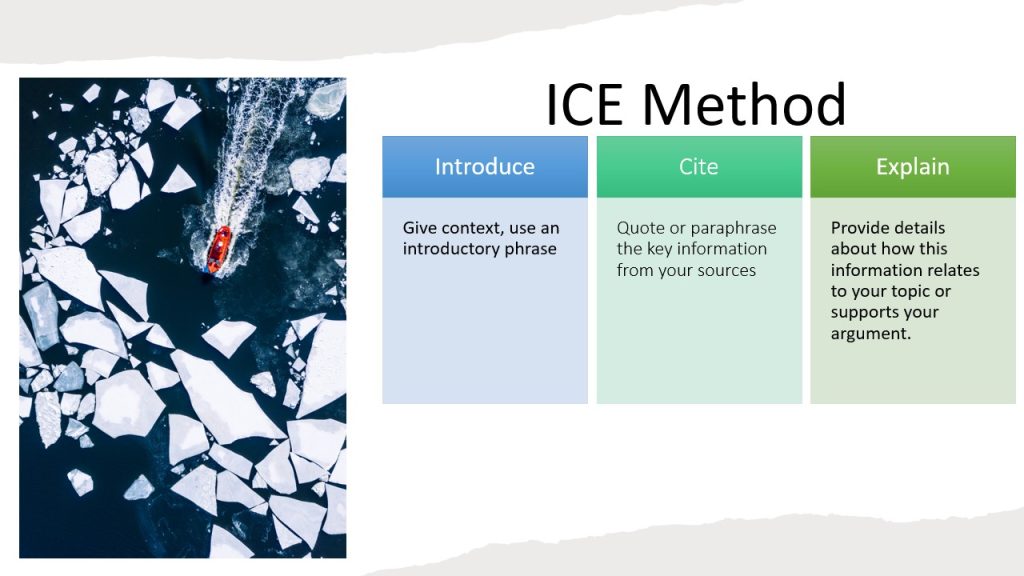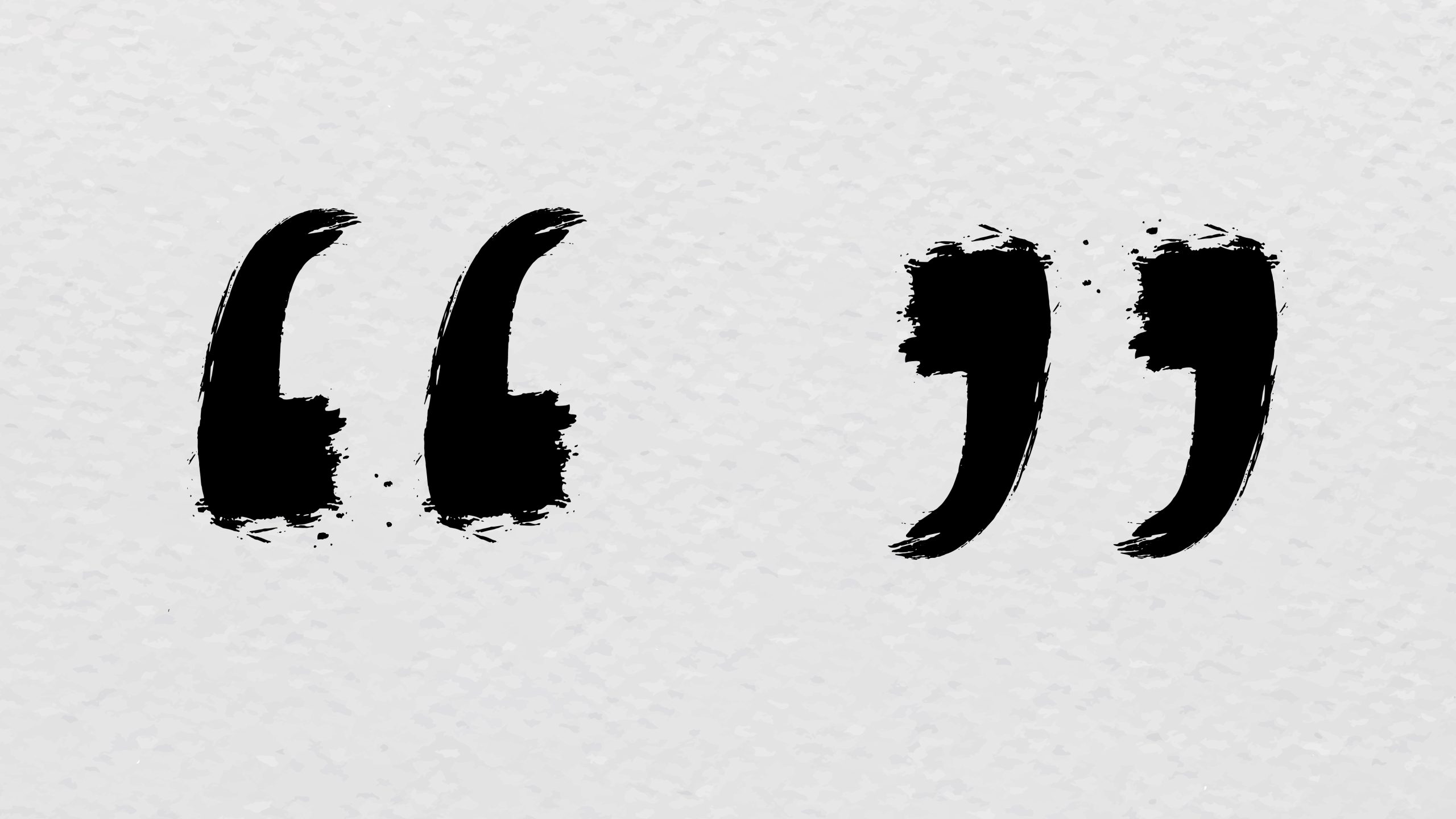And #11 Successful Students Learn Independently
18 Incorporating Information From Sources Into Your Writing
Before we begin
Before we begin, let’s review some common terminology used in this chapter.
How to Paraphrase and Summarize?

Paraphrasing and summarizing are important skills for academic writing as they allow you to incorporate information from webpages and other courses into your papers. This helps to demonstrate that you understand the information from the sources and how it relates to your assignment as well as assists you in avoiding plagiarism. Here is a discussion of the two skills:
Paraphrasing: Paraphrasing involves restating information from a source in your own words. This information is usually one idea or one fact. When paraphrasing, it is important to retain the meaning of the original text while using different words and sentence structure.
Summarizing: Summarizing involves condensing the main ideas of a source into a shorter form. The goal of summarizing is to capture the most important points of the source material while omitting fewer key details. Generally, a summary is a few sentences or one paragraph.
The basic steps for paraphrasing and summarizing are the same:
- Read the webpage carefully and highlight or take notes on the idea you want to include. Use keywords and phrases rather than copying a sentence or paragraph.
- Close the webpage and write down the main points of the webpage in your own words. This will help you avoid copying the original text.
- Compare your paraphrase or summary to the original text to ensure you retain the original’s meaning while using your own words.
- Cite the source of the information using the appropriate citation style.
Comparing Paraphrasing and Quoting
Process of Paraphrasing
Using Signal Verbs
If you want to smoothly integrate a smaller detail into your paper, use signal verbs.
Avoid verbs like “says,” “writes,” “states” or “discusses” tend to be commonly over-used to signal a quotation and are vague. The list of signal verbs below offers suggestions for introducing quoted, paraphrased, and summarized material that convey more information about the purpose of the information in the original source: What is the author doing in the quoted passage? Is the author describing something? Explaining something? Arguing? Giving examples? Estimating? Recommending? Warning? Urging? Be sure the verb you choose accurately represents the intention of the source text.
Commonly used signal verbs (Last, 2019):
- Making a claim: argue, assert, believe, claim, emphasize, insist, remind, suggest, hypothesize, Maintains.
- Recommending: advocate, call for, demand, encourage, exhort, implore, plead, recommend, urge, warn.
- Disagreeing or questioning: challenge, complicate, criticize, qualify, counter, contradict, refute, reject, deny, question.
- Showing: illustrates, conveys, reveals, demonstrates, proposes, points out, exemplifies, indicates.
- Expressing agreement: agree, admire, endorse, support, affirm, corroborate, verify, reaffirm.
- Additional signal verbs: responds, assumes, speculates, debates, estimates, explains, implies, uses.
Be careful with the phrasing after your signal verb. In some cases, you will use “that” to join the signal phrase to the summarized or paraphrased text:
- Smith argues that bottled water should not be allowed on college campuses (Smith, 20XX).
But not all signal verbs can be followed by “that.” We can use clauses with that after verbs related to thinking and after verbs related to saying.
The ICE model

The ICE model is a framework for incorporating sources into academic writing. The model consists of three components: Introduce, Cite, and Explain.
- Introduce: The first step is to introduce the source you will be using. This can be done by providing some background information on the author or the source itself. This helps to establish the context of the source and its relevance to the topic being discussed.
- Cite: The second step is to provide the important information from the source and a citation for the source being used. This includes the author’s name, the title of the work, and the publication information. The citation should follow the appropriate citation style guidelines.
- Explain: The last step is to explain how the source supports the point being made in the paper. The explanation should be detailed and provide a clear understanding of the source’s contribution to the paper.
Example 1:
Here is an example paragraph using the ICE model for an attraction on a provincial tourism website:
Introduce: Located in the heart of the Rocky Mountains, the Banff Gondola is one of the top attractions in Alberta, Canada.
Cite: According to the Banff Gondola website, “the eight-minute ride to the top of Sulphur Mountain offers stunning panoramic views of the surrounding mountains and valleys” (Banff Gondola, n.d., para. 2).
Explain: Visitors to the Banff Gondola can enjoy a range of activities at the summit, including guided interpretive walks, a visit to the interactive Above Banff Interpretive Centre, and dining with a view at one of the on-site restaurants. The Banff Gondola also offers seasonal experiences, such as stargazing in the evening or snowshoeing in the winter months. As the Banff Gondola is a popular attraction, visitors are encouraged to book their tickets in advance to secure their spot on this unforgettable experience.
As mentioned in the Paraphrasing and Summerizing section, after reading the website carefully, you should take some brief notes about the information you want to include in your paper. Here is an example of notes of the Banff Gondola attraction:
Sure, here is the outline rewritten in point form:
- Banff Gondola is a must-visit attraction in Alberta, Canada.
- Use a direct quote: “the eight-minute ride to the top of Sulphur Mountain offers stunning panoramic views of the surrounding mountains and valleys” (Banff Gondola, n.d., para. 2).
- Activities at the Summit: Guided interpretive walks, interactive Above Banff Interpretive Centre, On-site dining with a view
- Seasonal experiences such as stargazing in the evening or snowshoeing in the winter months.
- Importance of Booking Tickets in Advance
Example 2:
Here is an example paragraph using the ICE model for a food critic’s review of a new restaurant:
Introduction: The restaurant critics from The New York Times recently visited the newly opened restaurant, La Petite Brasserie, in downtown Manhattan.
Cite: As noted in the review by restaurant critic Jane Doe, because of its innovative treatment of French cuisine dishes everyone is talking about La Petite Brasserie(Doe, 2022 ).
Explain: Doe’s review highlights several standout dishes, including the restaurant’s signature dish, the Coq Au Vin. She also praises the restaurant’s attention to detail in plating which enhances each dish. Overall, Doe’s review presents La Petite Brasserie as a must-visit restaurant for lovers of French cuisine, with inventive dishes and impeccable presentation that are sure to impress even the most discerning of diners.
How to use ICE to write a paragraph
How to write a summary
Plagiarism—and How to Avoid It

Plagiarism is the unacknowledged use of material from a source. At the most obvious level, plagiarism involves using someone else’s words and ideas as if they were your own. There’s not much to say about copying another person’s work: it’s cheating, pure and simple. But plagiarism is not always so simple. Notice that our definition of plagiarism involves “words and ideas.” Let’s break that down a little further.
Words. Copying the words of another is clearly wrong. If you use another’s words, those words must be in quotation marks, and you must tell your reader where those words came from. But it is not enough to make a few surface changes in wording. You can’t just change some words and call the material yours; close paraphrasing is not acceptable.
Ideas. Ideas are also a form of intellectual property. When you are summarizing an original idea, that is, stating the main idea in compressed form in language that does not come from the original, it could still be seen as plagiarism if the source is not cited.
This probably makes you wonder if you can write anything without citing a source. To help you sort out what ideas need to be cited and what not, think about these principles:
Common knowledge. There is no need to cite common knowledge. Common knowledge does not mean knowledge everyone has. It means knowledge that everyone can easily access. If the information or idea can be found in multiple sources and the information or idea remains constant from source to source, it can be considered common knowledge.
Distinct contributions. One does need to cite ideas that are distinct contributions. A distinct contribution need not be a discovery from the work of one person. It need only be an insight that is not commonly expressed and not universally agreed upon.
Disputable figures. Always remember that numbers are only as good as the sources they come from. If you use numbers like attendance figures, unemployment rates, or demographic profiles or any statistics at all, always cite your source of those numbers.
Forms of Citation

You should generally check with your professors about their preferred form of citation when you write papers for courses. No one standard is used in all academic papers. You can learn about the three major forms or styles used in most any college writing handbook and on many Web sites for college writers:
- The Modern Language Association (MLA) system of citation is widely used but is most commonly adopted in humanities courses, particularly literature courses.
- The American Psychological Association (APA) system of citation is most common in the social sciences.
- The Chicago Manual of Style is widely used but perhaps most commonly in history courses.
Plagiarism Self-Check
Paraphrasing and Plagiarism Tutorial
Key Takeaways
- Paraphrasing and summarizing are crucial skills for academic writing, allowing you to incorporate information from various sources into your papers. They demonstrate your understanding of the material and help you avoid plagiarism.
- Paraphrasing involves restating information from a source using your own words while retaining the original meaning.
- Summarizing entails condensing the main ideas of a source into a shorter form, omitting less important details.
- The basic steps for paraphrasing and summarizing are the same: read the material carefully, take notes on the key points, write the information in your own words, compare to the original to ensure accuracy, and cite the source appropriately.
- Signal verbs can help smoothly integrate information into your paper. Choose appropriate verbs that accurately represent the intention of the source text.
- The ICE model (Introduce, Cite, Explain) is a framework for incorporating sources into academic writing. Introduce the source, cite the important information, and explain how it supports your point.
- Plagiarism involves using someone else’s words or ideas without proper acknowledgment. Always cite sources when using others’ words, even when summarizing an idea in your own language.
- Common knowledge doesn’t need citation, but distinct contributions and disputable figures require proper referencing.
- Different forms of citation (MLA, APA, Chicago Manual of Style) are used in academic papers; check with your instructor for the preferred citation style.
 Want more? Find out more about Paraphrasing and Summarizing from The Learning Portal
Want more? Find out more about Paraphrasing and Summarizing from The Learning Portal

